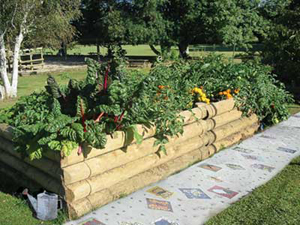|
||||||||||||||
|
||||||||||||||
%
responses |
||||||||||||||
y4 |
y8 |
|||||||||||||
| 1. Why do you think the teachers and children made this garden at their school? |
not marked |
• |
• |
|||||||||||
| The garden is growing very well. 2. What might the teachers and children have done to get the plants in their garden to grow so well? |
||||||||||||||
obtain good seeds/plants |
1 |
1 |
||||||||||||
use good soil (incl. worms) |
9 |
20 |
||||||||||||
add compost, fertiliser, etc. |
9 |
32 |
||||||||||||
water regularly and appropriately |
71 |
87 |
||||||||||||
remove weeds or prevent/
suppress weed growth |
3 |
12 |
||||||||||||
position and structure
(sun, wind protected, stakes for plants) |
34 |
44 |
||||||||||||
| Plants in gardens often have to be protected
from pests and disease. 3. What garden pests and disease can cause damage to plants? 4. What could the teachers and children do to protect their plants against pests and disease? |
||||||||||||||
| Walking animals on ground: (rabbits, possums, etc.) |
mentioned, with appropriate protection ideas |
6 |
8 |
|||||||||||
mentioned |
16 |
16 |
||||||||||||
not mentioned |
78 |
76 |
||||||||||||
| Slugs, snails, etc: |
mentioned, with appropriate protection ideas |
14 |
26 |
|||||||||||
mentioned |
29 |
38 |
||||||||||||
not mentioned |
57 |
36 |
||||||||||||
| Birds: |
mentioned, with appropriate protection ideas |
5 |
10 |
|||||||||||
mentioned |
9 |
12 |
||||||||||||
not mentioned |
86 |
78 |
||||||||||||
| Other flying creatures: (moths, butterflies, aphids etc.) |
mentioned, with appropriate protection ideas |
6 |
10 |
|||||||||||
mentioned |
19 |
29 |
||||||||||||
not mentioned |
75 |
61 |
||||||||||||
| Diseases: (e.g. blights, funguses, mildew, rotting) |
mentioned, with appropriate protection ideas |
0 |
1 |
|||||||||||
mentioned |
1 |
3 |
||||||||||||
not mentioned |
99 |
96 |
||||||||||||
| Overall rating for pests,
diseases, protection: |
very good/excellent |
0 |
4 |
|||||||||||
good |
10 |
20 |
||||||||||||
moderate/weak |
52 |
64 |
||||||||||||
no idea |
38 |
12 |
||||||||||||
| 5. Why do you think this school garden has been built up from the ground? |
||||||||||||||
| To make it easier to look after and protect: (e.g. people running through the garden) |
both |
1 |
3 |
|||||||||||
easier to look after |
3 |
5 |
||||||||||||
protection |
28 |
47 |
||||||||||||
no idea |
68 |
45 |
||||||||||||
to provide greater depth of soil |
5 |
9 |
||||||||||||
to improve drainage |
1 |
2 |
||||||||||||
| 6. Do you have a garden
at home? |
||||||||||||||
yes, specifically child’s |
3 |
3 |
||||||||||||
yes |
81 |
75 |
||||||||||||
no |
16 |
22 |
||||||||||||
Total
score: |
9–22
|
3 |
13 |
|||||||||||
7–8 |
8 |
23 |
||||||||||||
5–6 |
26 |
36 |
||||||||||||
3–4 |
31 |
20 |
||||||||||||
0–2 |
32 |
8 |
||||||||||||
| Subgroup Analysis [Click on charts to enlarge] : |
| Commentary: |
| Despite most students indicating that there was a garden at their home, the requirements for successful gardens were not well understood by most students. Pasifika students had particularly low scores at both year levels. |


